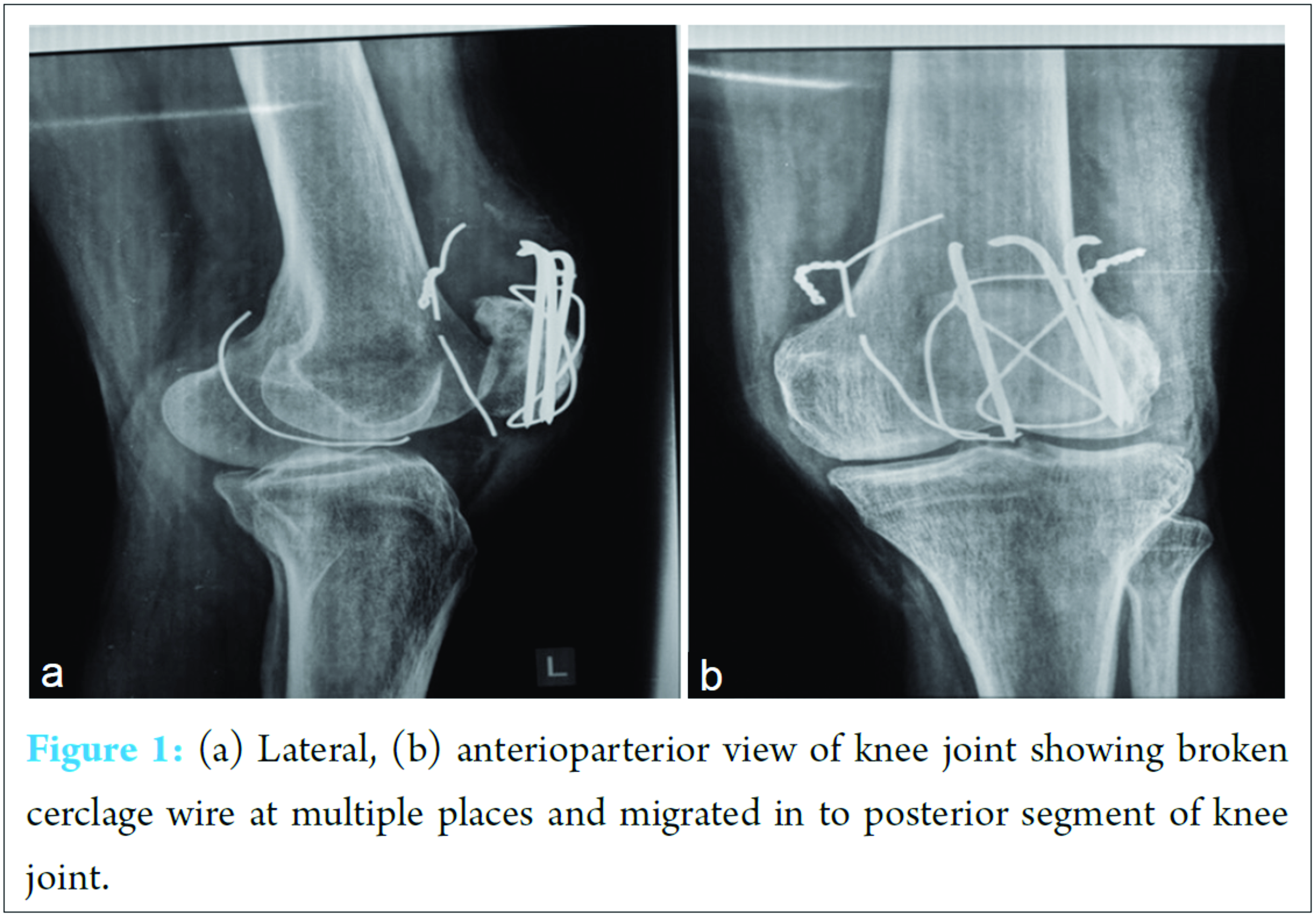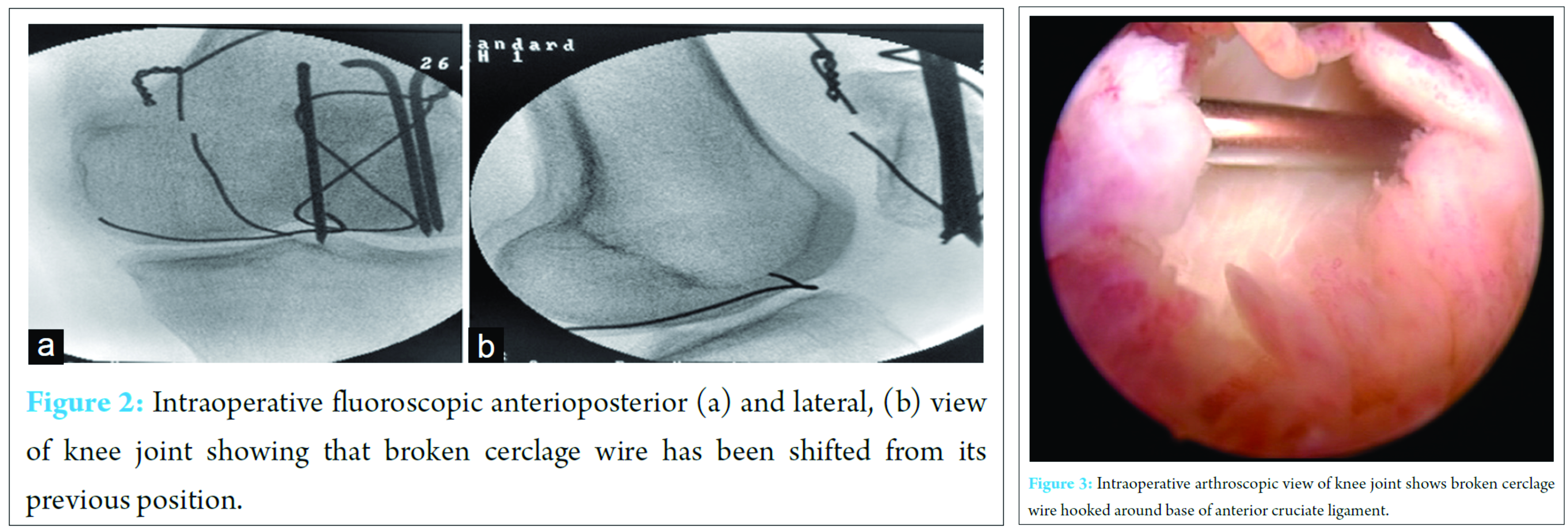[box type=”bio”] What to Learn from this Article?[/box]
While removing broken intra-articular wire, the patient should be counseled for removal, otherwise it may damage neurovascular structure or articular cartilage or ligaments.
Case Report | Volume 6 | Issue 5 | JOCR November-December 2016 | Page 41-43| Satish Kumar Sharma, Sonendra Kumar Sharma, Mohammed Aslam, Gagan Naresh Chadha DOI: 10.13107/jocr.2250-0685.622
Authors: Satish Kumar Sharma[1], Sonendra Kumar Sharma[1], Mohammed Aslam[1], Gagan Naresh Chadha[1]
[1]Department of Orthopaedics, Sir Ganga Ram Hospital, New Delhi, India.
Address of Correspondence
Dr. Sonendra Kumar Sharma,
Department of Orthopaedics, Sir Ganga Ram Hospital, New Delhi. India.
E-mail: dr.sonendra@gmail.com
Abstract
Introduction: Comminuted fracture of patella is most commonly treated by tension band wiring with cerclage wiring. Broken cerclage wiring after such surgery is not uncommon but intra-articular migration of broken cerclage wire is rarely known and described complication.
Case Presentation: A 51-year-old male patient of Indian origin which was treated, 15 months back for fracture patella with tension band wiring with cerclage wiring, presented with painful restriction of knee movements for the last 4 weeks. X-ray showed cerclage wire had broken at multiple sites with one broken piece migrated intra-articular. This case is unique due to the size of migrated broken cerclage wire which was about 4.5 cm long, second the anterior part of broken wire was hooked around anterior cruciate ligament, which prevented its further migration otherwise neurovascular structures could have been damaged. This intra-articular piece of wire was removed arthroscopically.
Conclusions: We recommend that all patients receiving bone fixation with wires should be counseled about the risks of hardware failure and possible migration, with the option of elective hardware removal discussed. In addition, when wire breakage is detected radiologically, the patient should be strongly advised to have the wires removed as soon as possible.
Keywords: Arthroscopic removal, broken cerclage wire, intra-articular migration.
Introduction
Modified tension band wiring with cerclage wiring is a routinely performed procedure for treating displaced patellar fractures. Subsequent breakage of the wire is not uncommon, but migration of a fragment of the broken wire has not been well described [1, 2, 3]. To our knowledge, seven reports describe such migration following tension band or cerclage wiring for seven patellar fractures, and only three cases of intra-articular translocation of a wire fragment have been documented.
Here, we present a rare case of intra-articular migration of broken tension band wire, with one side of it was hooked into the base of anterior cruciate ligament of the knee.
Case Report
A 51-year-old man reported with complaints of recent onset of left knee pain. He had sustained a displaced comminuted fracture of his left patella following a fall 15 months ago. Modified tension band wiring with cerclage wiring was successfully performed, and the patient was recovering well. He was well for the last 14 months and returned to his job without any pain or functional disability. However, he started experiencing deep-seated pain within the left knee with restriction of movements for the last 4 weeks. There was no recent history of any fall or trauma to the left knee. Clinical examination of the left knee revealed no patella or joint line tenderness but pieces of wires were palpable percutaneously. There was no effusion and the cruciate and collateral ligaments were intact; there was no neurovascular deficit. There was no extensor lag and knee extension power was normal. The range of motion of the knee was painfully restricted.
Radiographs of the left knee revealed a united fracture patella with broken cerclage wire (Fig. 1). The inferio-medial segment of the broken cerclage wire was found to have migrated into the posterior compartment of the knee joint and hooked anteriorly at the base of anterior cruciate ligament.
The inferio-medial segment of the broken cerclage wire was found to have migrated into the posterior compartment of the knee joint and hooked anteriorly at the base of anterior cruciate ligament.
The patient underwent surgery for removal of the patella wires. Fluoroscopic examination before surgery revealed the posterior part of wire had shifted its position with anterior part of it still hooked with anterior cruciate ligament. An arthroscopic examination of the knee was done through the standard anteromedial and anterolateral portal. Any structural damage including chondral lesion due to wire migration was not found, a migrated piece of wire was found embedded at the base of anterior cruciate ligament, going toward posterior compartment of knee through medial side of notch, which was removed (Fig. 2). We used intraoperative fluoroscopy (Fig. 3), before finishing the arthroscopic examination of knee, which demonstrated that, there was no remaining piece of wire in posterior compartment of knee. The rest of the broken wires were removed via a midline anterior knee incision along the old scar. The patella was stable after complete removal of the wires, indicating union of the rest of the fragments.
The patient was discharged the next morning and his wounds healed at 2 weeks. Complaints of knee pain resolved completely following the surgery, and the patient was able to resume work at 2 weeks.
Discussion
The literature mentions very few cases of wire fragment migration. Those reported describe migration from the patella to the tibia, knee joint, posterolateral or posterior aspect of the knee, and the right ventricle of the heart [1, 2, 3, 4, 5, 6, 7, 8].
Specific to patella wires, only one case of intra-articular migration of a patella wire has been documented in the literature [5]. Choi et al. reported 2 cases of extra-articular patella wire migration to the popliteal fossa [1]. Biddau et al. reported a rare case of patella cerclage wire migration into the heart presumably via the blood circulation [2]. In this case, migrated piece of wire was very long (4.5 cm), piece was hooked at the base of anterior cruciate ligament which prevented further migration otherwise could have damaged neurovascular structures.
It has been suggested that activity level and age may be factors predictive of implant failure and possible migration [1, 3]. Proper surgical technique with symmetrical twisting of the tension band wire and correct choice of fixation should be enforced to ensure bony union and reduce hardware fatigue [10, 11, 12].
To reduce the risk of complications related to conventional tension band wiring using a K-wire and metal wires, several novel techniques have been developed [9].
Although a lower complication rate was reported using these techniques, the conventional tension band wiring described by the AO Foundation is still the most widely used [12]. Thus, careful long-term follow-up is advised, and once the breakage of hardware is observed, the patient should be strongly advised to have the hardware removed.
We should be mindful of the deleterious effects of intra-articular migration of hardware. These potentially include pain, locking symptoms, higher risks of Infection, and early degenerative wear. In this patient, acute pain and restriction of movements prompted the patient to seek medical attention. The intra-articular wire was mobile in the joint and produced pain and restricted movements.
Conclusion
We recommend that all patients receiving bone fixation with wires should be counseled about the risks of hardware failure and possible migration, with the option of elective hardware removal discussed. In addition, when wire breakage is detected radiologically, the patient should be strongly advised to have the wires removed as soon as possible.
Clinical Massage
Intra-articular migration of broken wire after patellar fracture fixation is although rare, but if it occurs, the patient should be counseled for removal of broken piece of wire; otherwise, it may damage neurovascular structures or articular cartilage or ligaments.
References
1. Choi HR, Min KD, Choi SW, Lee BI. Migration to the popliteal fossa of broken wires from a fixed patellar fracture. Knee 2008;15(6):491-493.
2. Biddau F, Fioriti M, Benelli G. Migration of a broken cerclage wire from the patella into the heart. A case report. J Bone Joint Surg Am 2006;88(9):2057-2059.
3. Chen YJ, Wu CC, Hsu RW, Shih CH. The intra-articular migration of the broken wire: A rare complication of circumferential wiring in patellar fractures. Changgung Yi Xue Za Zhi 1994;17(3):276-279.
4. Wang L, Lee KT. Locking knee after intra-articular migration of broken patella tension band wire: An extraordinary intra-articular migration via pseudarthrosis line. Acta Orthop Traumatol Turc 2013;47(6):444-447.
5. Tamaki Y, Nakayama T, Kita K, Miyatake K, Kawasaki Y, Fujji K, et al. Arthroscopic removal of a wire fragment from the posterior septum of the knee following tension band wiring of a patella fracture. Case Rep Orthop 2015;2015:1-5.
6. Meena S, Nag HL, Kumar S, Barwar N, Mittal S, Singla A. Delayed migration of K-wire into popliteal fossa used for tension band wiring of patellar fracture. Chin Med Assoc 2013;16(3):186-188.
7. Smith ST, Cramer KE, Karges DE, Watson JT, Moed BR. Early complications in the operative treatment of patella fractures. J Orthop Trauma 1997;11(3):183-187.
8. Konda SR, Dayan A, Egol KA. Progressive migration of broken Kirschner wire into the proximal tibia following tension band wiring technique of a patellar fracture–case report. Bull NYU Hosp Jt Dis 2012;70(4):279-282.
9. Berg EE. Open reduction internal fixation of displaced transverse patella fractures with figure-eight wiring through parallel cannulated compression screws. J Orthop Trauma 1997;11(8):573-576.
10. Qi L, Chang C, Xin T, Xing PF, Tianfu Y, Gang Z, et al. Double fixation of displaced patella fractures using bioabsorbable cannulated lag screws and braided polyester suture tension bands. Injury 2011;42(10):1116-1120.
11. Yotsumoto T, Nishikawa U, Ryoke K, Nozaki K, Uchio Y. Tension band fixation for treatment of patellar fracture: Novel technique using a braided polyblend sutures and ring pins. Injury 2009;40(7):713-717.
12. Muller ME, Allgower M, Schneider R, Willenegger H. Manual of Internal Fixation: Techniques Recommended by the AO Group. Berlin: Springer-Verlag; 1979. p. 248-253.
| How to Cite This Article: Kumar S, Sharma SK, Aslam M, Chadha GN. Intra-articular Migration of Broken Patellar Tension Band Wire: A Rare Case. Journal of Orthopaedic Case Reports 2016 Nov-Dec;6(5):41-43. Available from: https://www.jocr.co.in/wp/2016/11/10/2250-0685-622-fulltext/ |
[Full Text HTML] [Full Text PDF] [XML]
[rate_this_page]
Dear Reader, We are very excited about New Features in JOCR. Please do let us know what you think by Clicking on the Sliding “Feedback Form” button on the <<< left of the page or sending a mail to us at editor.jocr@gmail.com





